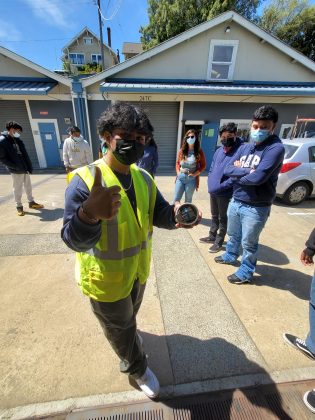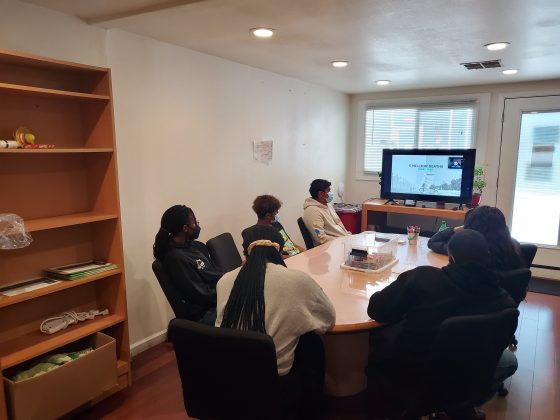Youth Engagement as a Catalyst for Environmental Action in Richmond, California
Richmond has some of the worst air pollution levels in the entire state of California. Located at the epicenter of oil refineries and transportation infrastructure, including two major highways, and in close proximity to smoke from wildfires, many of Richmond’s residents, particularly young people, have experienced very high rates of asthma and other respiratory conditions. The air quality crisis is made worse by the lack of trees and vegetation in the city. Trees are the most effective ways to filter out pollutants, but the city’s average tree canopy coverage is currently just 12.7%, significantly below the recommended urban tree canopy coverage targets of 25% to 35%. Since it was founded in 2010, Groundwork Richmond has prioritized working with young people from the community to address this growing health crisis through city-wide urban greening and tree planting efforts to improve air quality and increase access to healthy outdoor spaces.
Harnessing youth power to tackle air pollution
Five years ago, Groundwork Richmond joined a partnership between the City of Richmond and Ramboll Engineering Consultancy to implement a network of air quality monitors across the city to provide real-time data on pollution levels. With support from California’s Community Air Grant Program, Groundwork Richmond established its Air Rangers program to employ and train young people (aged 15 to 25) to manage the on-the-ground work required for the monitoring program, including installation, use, and maintenance of remote air quality sensors. These sensors, located in homes, parks, and public spaces throughout Richmond, collect real-time data on neighborhood-level air quality to help residents make informed choices for themselves and their families about where and how they spend their time outdoors.

Since its inception, the Air Rangers program has successfully taught youth to install air quality sensors and connect them to the broader network of monitors across the city, as well as how to perform monthly routine checkups and retrieve sensor data. In the first two rounds of program funding, Air Rangers installed 47 air quality monitors to measure hyperlocal nitrogen dioxide and particulate matter concentrations and set up additional sensors to measure black carbon and toxic metal concentrations.

To help spread the word about the available air quality resources and their findings, the youth involved in the program have also been leading community outreach efforts. During an informational webinar for the Richmond community highlighting findings from the air monitoring program, several members of the Air Rangers program discussed their experiences doing hands-on air quality monitoring work and shared information about the negative health impacts of poor air quality on their communities.
Now entering its third cycle, Air Rangers will focus more acutely on community engagement while providing air quality sensors to low-resource Richmond neighborhoods. The new sensors that Air Rangers will be installing are more affordable and user-friendly than the ones used in previous phases, making air quality data more accessible to non-scientists and empowering residents to make informed decisions for themselves and their families. Youth will install 20 of these improved monitors in residents’ homes and 10 more in public areas around the city, targeting the areas that lack sensors – often areas that also lack trees.
In this new phase of the program, Air Rangers will be leading several community outreach efforts, including canvassing door-to-door around the city, tabling at community events, passing out informational flyers, and posting on social media. As part of their outreach plan, they are also partnering with the City of Richmond to host a Clean Air Day event to increase community engagement with the program. The team will share their personal experiences living with air pollution and their monitoring efforts to improve air quality in the city.

what has made Air Rangers successful?
Air pollution is no easy problem to solve. Groundwork Richmond’s Air Rangers program employs a multifaceted approach combining youth engagement, citizen science, and data mapping to address poor air quality holistically. The key to building an effective youth program like Air Rangers is establishing and maintaining strong connections within the community and designing programs around their vision and needs. Workforce Development Director at Groundwork Richmond, Sarah Calderon, advises, “Rather than being prescriptive and telling the community what it needs, we need to engage the community to find out what they would like and how [youth programs] fit in. When we say community, we oftentimes forget that includes youth, as well.” Not only have youth been instrumental in carrying out the Air Rangers program through monitor installation and outreach, but they have also shaped the program to suit the needs and interests of the community. In this third phase of the program, the youth proposed projects that they wanted to work on to improve air quality in Richmond, contributed to the grant writing process for the Clean Air Day event, and collaborated to determine what the event should look like to make the biggest impact.

It is also necessary to establish strong partnerships with other community organizations that can fill in expertise gaps when creating youth-centered programs. In the case of Air Rangers, Groundwork Richmond could not execute the program on its own. Lorena Castillo, co-executive director of Groundwork Richmond, explains, “We’re not scientists and Air Rangers is a very science-heavy program. So we relied on our partners to support us and disseminate scientific information in a way that’s palatable to regular citizens like us.” Collaborating with the City and Ramboll allowed Groundwork Richmond to organize the youth and community engagement pieces of the program without compromising the importance of the scientific research component of air quality monitoring.
No youth program is perfect from the start. Megan Lamb, co-executive director of Groundwork Richmond, emphasizes reflection as an important part of the process. “For any program–Air Rangers, youth program, or anything else–make sure to have time for reflection both for the participants and the staff. Without time to reflect on Air Rangers I and II, we wouldn’t have really shifted from being more data-heavy to more community engagement-focused. We were very intentional with that to better meet the needs of the community.”
By prioritizing the needs of the Richmond community and leveraging partnerships, the Air Rangers program provides youth with opportunities to address environmental issues that impact their everyday lives while also empowering them to use data to make informed decisions about their health and community. Simultaneously, youth have actively contributed to improving the program itself, shaping the scope of their work and bringing needed community perspectives into the conversation.
To learn more about Groundwork Richmond and the Air Rangers program, visit: Groundwork Richmond
